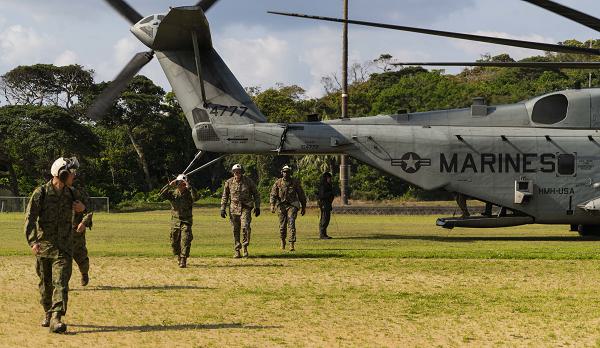
Okinoerabu, Japan. (February 14, 2025): It was during the Revolutionary War that the first American ship was sunk by sea mines, wooden kegs filled with gun powder. Ever since, ship captains have dreaded colliding with these underwater menaces. Today, however, they can send a “Super Stallion” to hunt them down and kill them. In this photo by Captain Pawel Puczko, a CH-53E Super Stallion helicopter, attached to the 31st Marine Expeditionary Unit, takes part in joint operations with Japan’s Self Defense Forces. The Japanese have acquired eleven Super Stallions of their own and train regularly with the Marines in counter-mining operations.
Built by Sikorsky Aircraft specifically for the Marines, the Super Stallion entered service in 1981 and is one of the largest helicopters in service. Able to operate off Navy ships, the CH-53E version is designed for airborne mine detection and countermeasures. It is also a heavy lift chopper that can be used for ship-to-shore transport and for vertical on-board delivery of supplies. It can carry up to fifty-five troops or a sixteen-ton payload fifty-nautical miles. An extremely capable aircraft, the Super Stallion can be refueled in-flight, even when hovering, which increases its range and ability to loiter over a target. What makes the MH-53E version special is its digital flight-control system specifically designed to haul minesweeping gear.
Here's how it works. The Super Stallion hunts for mines by towing highly specialized mine-sweeping equipment behind it while flying above the water. The aircraft literally drags an area looking to detect and neutralize mines while keeping a safe distance. It’s unique flight controls maintain precise positioning while towing their mine-hunting equipment.
In essence, the Super Stallion has a two-part mission; detect and destroy. To locate mines, the Navy employs a side-scanning sonar that provides high-resolution, real-time detection with high area coverage rates. Once detected, the Super Stallion uses the Mk105 magnetic minesweeping sled to collide with and detonate the mines.
Unlike their Revolutionary War comrades, today’s skippers can rely on the Super Stallion to keep their vessels safe.


